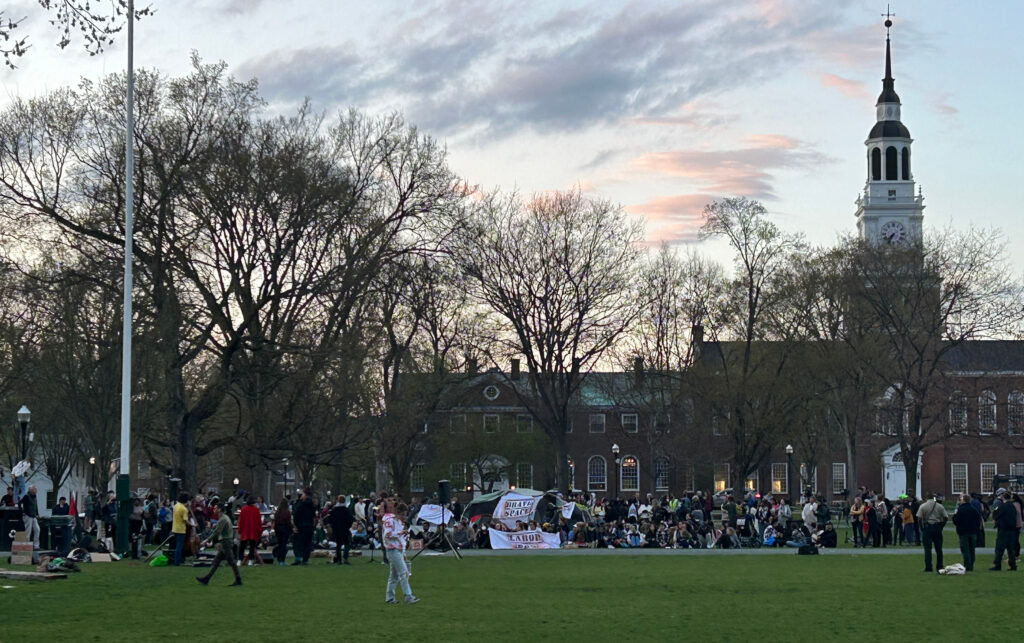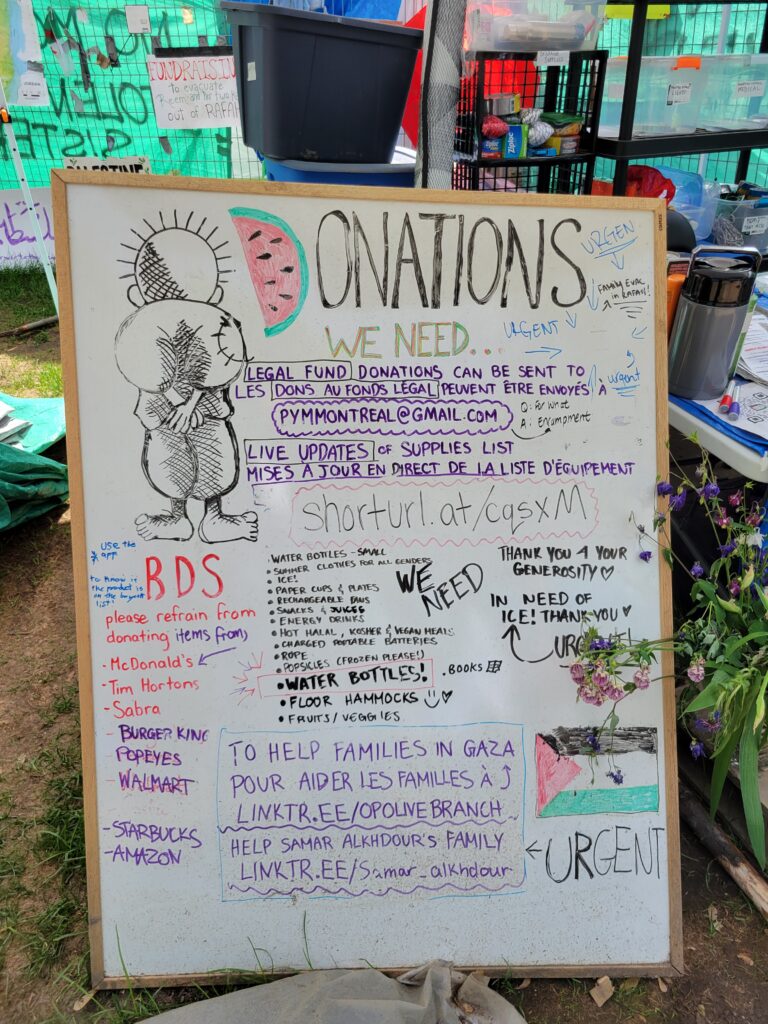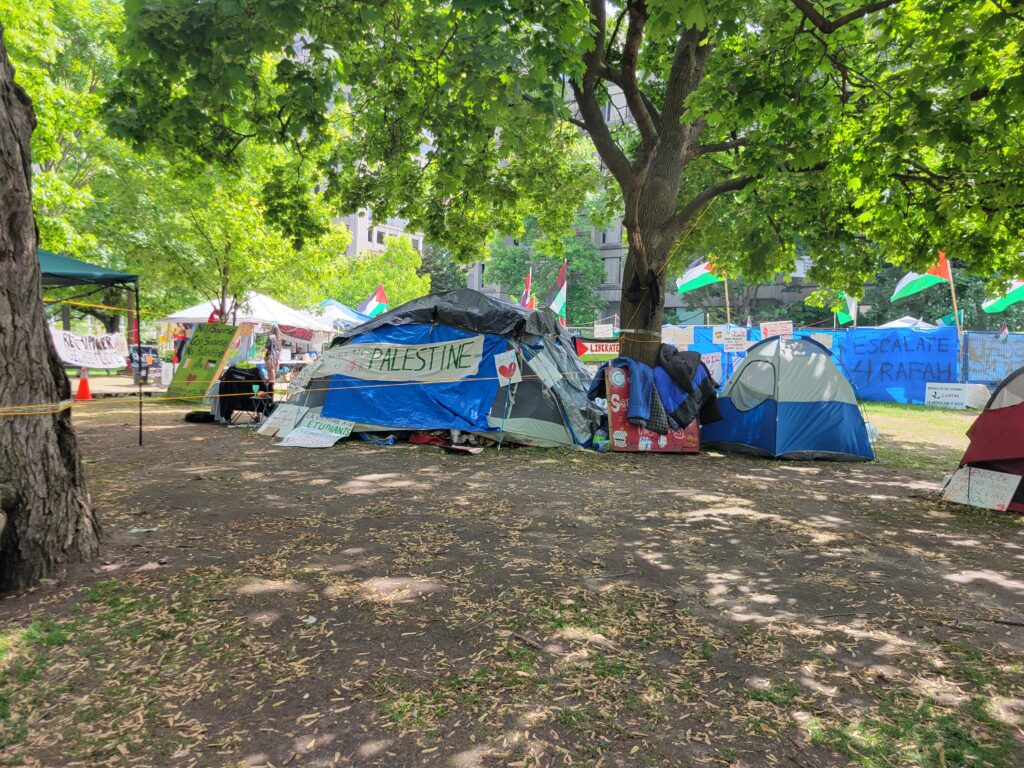Occupations and encampments have been the mode of choice for manifesting support for Palestinians in Gaza, for demanding that University endowment funds divest from investments profiting from the Israel war on Hamas and invasion of Gaza. These are indebted to sit-ins and occupations of the late 1960s, the squatter movements of the 60s and more recently (Herbert & Ricketts, 2024), and also occupations such as Occupy Wall Street (2010) and the Arab Spring occupation of Tahriz Square in Cairo (2010), and later the Standing Rock (North Dakota) No Dakota Access Pipeline movement on Sioux lands in 2016 (Powell & Draper, 2020). Euro-Maidan I and II, in Kyiv’s Maidan Square demonstrated the potential of occupations to change State regimes. What does the academic literature tell us about occupations as a strategy?

“the iconic moments, the images that promise to become monuments, of the global revolution of 2011 are not those of face but of space; not figures, but the negative space or ground against which a figure appears. The figure that circulates globally, that embraces both Tahrir Square and Zuccotti Park, and has perhaps been overlooked because it is hiding in plain sight, is the figure of occupation itself.”
(Mitchell, 2012)
Occupations and protest encampments share with protest rallies and marches and everyday conflicts a politics of direct presentation and often the occupation of space through autonomous organization. De la Llata notes that they embrace conflict, creative resistance and critical proactiveness (De la Llata, 2020). Senf characterizes them as “corrective struggles” defending against the withdrawal of social recognition of the marginalized, “inclusive struggles” to expand participatory democracy and “change struggles” that oppose inequality and disrespect in the market economy and finally as “antidemocratic protest” responding to injustice but demanding exclusion of others (Senf, 2023) such as migrants or minorities.
They are sites of experimentations in collaboration and solidarity. Participants and those attending experience a public pedagogy related to the issues at hand and are inducted into experimental forms that address those issues using the encampment as a lab and microcosm of society (Powell & Draper, 2020). Recent Marxist class critiques using framework of the “Right to the City” (Attoh, 2011; Lefebvre, 1995; Vasudevan, 2015) pointed out the neglect of Occupy’s parallels to and tensions with houseless occupation of public space (Fortin, 2015; Schein, 2012). Decolonial critique has subjected the notion of “occupation” to critical review for its parallels to colonial occupation and displacement of Indigenous inhabitants. Encampments of the last decade have thus sought to “bring forth a world” (cf. The Zapatistas of Chiapas in 1994 and recent Indigenous movements, see Escobar, 2018).

Even when encampments do not articulate clear demands or solutions they are commons, insurgent worldings that contrast to the “lawscape” and regime of the everyday life as it is being lived in contemporary societies. This also applies to encampments of the houseless and homeless (Braimoh et al., 2023) and other marginal and precarious spaces (Agier, 2020). Citizens who take up residence outside of the formal property system lose their relation to representatives under the place-based voting systems of representative democracies which assume citizens are legally and officially located in places of residence to which they are legally connected through rental contracts, property titles and tax rolls (see also Przybylinski, 2021).
Occupants are in effect experimenting with new models of citizenship, belonging and community-relatedness. These new visions and practices are sketches of new ways of living together, new urbanities, as if staged in a one-act play. Encampents are radical infrastructures for commons and “commoning.” They prefigure and materialize a social order that the occupants seek to enact. The role of occupations as spatial forms reinstate the possibility of autonomous dwelling and community outside of State-based institutions and tutelage. Encampments such as Occupy Gezi Park in Istanbul (2013) depended on new alliances and affective involvement between different social groups and diverse class segments to create an unspoken consensus on collective togetherness. This extended to relations with the environment (see also the 1992-93 Clayoquot Protests which blockaded lumber company access to clearcut old growth forests). This involved new forms of urban being, acting and living together even if the camps were unstable and exposed pre-existing inequalities that couldn’t be reconciled within Gezi itself (Özkaya, 2023). While they are utopian moments, occupations can reaffirm social divisions internally as well as highlighting the politics around the presence of a camp.
Occupations materialize both political issues and economic divisions. In so doing they raise state anxieties as racial and gendered economic divisions are plainly visible and personified by the occupiers. They have become opportunities to problematize the entire legitimacy of the project of the settler-colonial nation state and contemporary capitalism (Bosworth & Chua, 2023). By demonstrating an alternative to the status quo, Occupations make evident and materialize the potential of Indigenous and local “countersovereignties” against the authority of the State and/or Crown (Coulthard, 2014, p. 118)

By way of critique, such encampments are portrayed as criminal, morally lax, lazy and enabled through state welfare support. Against critical assessment of the socioeconomic roots of precarity, this frames and delegitimizes the occupations and occupants in favour of authorities’ approach to “criminalize, displace, disband and exclude” and to frame arguments against occupants in terms of pitting them against another group’s interest (Dindyal, 2020). An alternative in the City of Portland, permitted encampments have been legalized. This is argued to be part of a form of “governing-though-emergency” (Przybylinski, 2024). Legalization gives s a social and legal foundation that incorporates encampments into the shelter strategy of local welfare State and social service providers.
Property law sets the eventual boundaries of occupations as they are dispersed by authorities. In legal studies of homeless encampments in British Columbia, a province of Canada, Wood found that lower court judges almost always granted interlocutory injunction applications to evict encampment residents. That means that lower courts are deciding complex, contested constitutional and evidential issues at the interlocutory stage on the basis of affidavit evidence from authorities alone. Instead the extraordinary character of interlocutory injunctions should be reasserted rather than treating them as routine in homeless encampment litigation. Lower court judges are thus playing a key role in setting and enforcing “public” and “private” interests (Wood, 2022).

Protest occupations are not merely events or occasions, they are alternative social spaces and worlds in as much as space is a resource and the material relations and coordinations set up in an encampment are the infrastructure of that social space (Savio, 2016). Rather than at the level of formal political demands, encampments operate at the level of everyday relations and it is this more intimate arena and order of social interaction which elevates an Occupation to the status of a new world (see Dekker & Duyvendak, 2020). Each of these events has contributed to challenging the image and sense of legitimate political protest. Occupations have created the conditions for the emergence of new, radical political imaginaries (Soudias, 2020). This marks them as distinct from the protests of the 1960s and 70s, a comparison often advanced in media speculation. In summary:
- Occupations and Encampments are spatial forms of direct democracy.
- Those of the last decade have built on but are distinct from previous protests and occupations.
- Occupations have been suppressed by being framed as illegitimate, by being legitimized by being incorporated into housing policies, and dispersed through police action supported by summary forms of legal judgment in which flimsy legal argument often ignores their complexity in constitutional and factual terms.
- They utilize the space of the occupation as a radical infrastructure to support experiments in alternative visions of society and its relations.
- Internally they are sites and commons of experimentation in collaboration and solidarity, community and forms of citizenship.
- One distinction is that current occupations operate not only on the register of explicit political demands but at the intimate scale of experimental and utopian relations of everyday life.
- Externally, Occupations put on display and highlight socioeconomic and political divisions. These may be unresolvable, but others may change State regimes (EuroMaidan), others have fundamentally shaped public opinion and policy on the environment (Clayoquot Protests).
- As a result Occupation raises the anxieties of authorities and in the North American context, they raise questions around the long-term legitimacy of the Settler Colonial State.
-Rob Shields (Univ. of Alberta)
References
Agier, M. (2020). Ch. 2 Camps, Encampments, and Occupations: From the Heterotopia to the Urban Subject. In Reflections on Life in Ghettos, Camps and Prisons (p. 13pp.). Routledge.
Attoh, K. A. (2011). What kind of right is the right to the city? Progress in Human Geography, 35(5), Article 5. https://doi.org/10.1177/0309132510394706
Bosworth, K., & Chua, C. (2023). The Countersovereignty of Critical Infrastructure Security: Settler-State Anxiety versus the Pipeline Blockade. Antipode, 55(5), 1345–1367. https://doi.org/10.1111/anti.12794
Braimoh, J., Dej, E., & Sanders, C. (2023). “Somebody’s Street”: Eviction of Homeless Encampments as a Reflection of Interlocking Colonial and Class Relations Special Issue on Housing Precarity and Human Rights. Journal of Law and Social Policy, 36, 12–31.
Coulthard, G. S. (2014). Red skin, white masks: Rejecting the colonial politics of recognition. University of Minnesota Press.
De la Llata, S. (2020). Beyond representation. Overcoming the trap of representation through autonomous organization and prefigurative politics in the square movements. Geoforum, 108, 70–79. https://doi.org/10.1016/j.geoforum.2019.11.006
Dekker, M. J. T., & Duyvendak, J. W. (2020). Justifying the protest camp: How Occupy movements’ ‘intimate protest’ challenged ideas about legitimate manifestation. European Journal of Cultural and Political Sociology, 7(4), 452–476. https://doi.org/10.1080/23254823.2020.1777441
Dindyal, S. (2020). ‘Out of Sight Out of Mind’: A City’s Position on Local Encampments a Critical Discourse Analysis of Secondary Discourse, about Homelessness and Responsibility in the Hamilton Community. https://macsphere.mcmaster.ca/handle/11375/25965
Escobar, A. (2018). Designs for the Pluriverse: Radical Interdependence, Autonomy, and the Making of Worlds. Duke University Press.
Fortin, V. (2015). Occupation, Exclusion and the “Homeless Problem” during Occupy Montreal (SSRN Scholarly Paper 2569088). https://papers.ssrn.com/abstract=2569088
Herbert, C. W., & Ricketts, A. V. (2024). Resisting and Reclaiming: Squatting as Contentious Urban Politics in the U.S. Social Problems, spae023. https://doi.org/10.1093/socpro/spae023
Lefebvre, H. (1995). Henri Lefebvre Writings on Cities. Blackwell.
Mitchell, W. J. T. (2012). Image, Space, Revolution: The Arts of Occupation. Critical Inquiry, 39(1), 8–32. https://doi.org/10.1086/668048
Özkaya, D. (2023). Revisiting the Promises and Inspiration of Turkey’s Gezi Uprisings through an Affective Reading of Collective Action. In The Affective Dynamics of Mass Protests. Routledge.
Powell, D. E., & Draper, R. (2020). Making It Home: Solidarity and Belonging in the #NoDAPL/Standing Rock Encampments. Collaborative Anthropologies, 13(1), 1–45.
Przybylinski, S. (2021). Realizing citizenship in property: Houseless encampments and the limits of liberalism’s promise. Political Geography, 91, 102494. https://doi.org/10.1016/j.polgeo.2021.102494
Przybylinski, S. (2024). From Rejection to Legitimation: Governing the Emergence of Organized Homeless Encampments. Urban Affairs Review, 60(1), 118–148. https://doi.org/10.1177/10780874231162923
Savio, G. (2016). Occupying Organization: Space as Organizational Resource in Occupy Wall Street. In Protest, Social Movements and Global Democracy Since 2011: New Perspectives (Vol. 39, pp. 59–83). Emerald Group Publishing Limited. https://doi.org/10.1108/S0163-786X20160000039003
Schein, R. (2012). Whose Occupation? Homelessness and the Politics of Park Encampments. Social Movement Studies, 11(3–4), 335–341. https://doi.org/10.1080/14742837.2012.708834
Senf, C. (2023). Occupying a Square? : A Recognition Theory of Social Movements in the Age of Wealth-Induced Political Inequality [Doctoral thesis, The University of Bergen]. https://bora.uib.no/bora-xmlui/handle/11250/3042185
Soudias, D. (2020). Spatializing Radical Political Imaginaries: Neoliberalism, Crisis, and Transformative Experience in the Syntagma Square Occupation in Greece. Contention, 8(1), 4–27. https://doi.org/10.3167/cont.2020.080103
Vasudevan, A. (2015). The autonomous city: Towards a critical geography of occupation. Progress in Human Geography, 39(3), 316–337.
Wood, S. (2022). Reconsidering the Test for Interlocutory Injunctions Affecting Homeless Encampments: A Critical Assessment of BC Case Law (SSRN Scholarly Paper 4297377). https://doi.org/10.2139/ssrn.4297377
